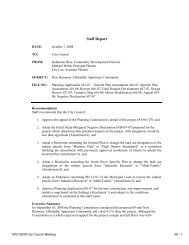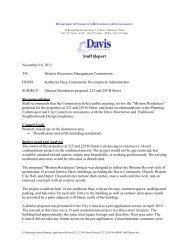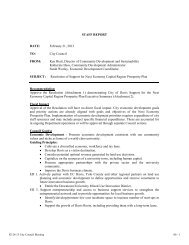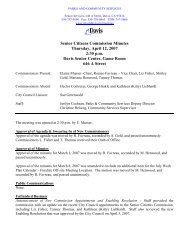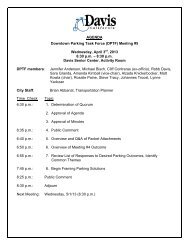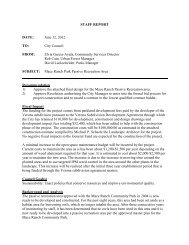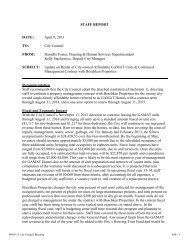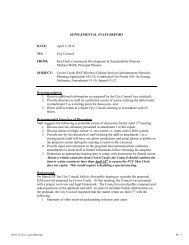10 Draft Integrated Waste Management Plan - City Council - City of ...
10 Draft Integrated Waste Management Plan - City Council - City of ...
10 Draft Integrated Waste Management Plan - City Council - City of ...
You also want an ePaper? Increase the reach of your titles
YUMPU automatically turns print PDFs into web optimized ePapers that Google loves.
2012 Davis <strong>Integrated</strong> <strong>Waste</strong> <strong>Management</strong> <strong>Plan</strong><br />
A zero waste strategy is timely for the <strong>City</strong>. The state has set a target date for achieving zero waste statewide by<br />
2025. Other California municipalities have either established such goals or are in the process <strong>of</strong> adopting them.<br />
In December 2011, the <strong>City</strong> <strong>Council</strong> approved a resolution giving the <strong>City</strong> a goal <strong>of</strong> achieving 1.9 pounds <strong>of</strong><br />
waste generated per person, per day (75% diversion equivalent) by 2020, as calculated by CalRecycle, through<br />
zero waste strategies. This was a landmark event and made Davis the first jurisdiction in the Central Valley<br />
area to implement a zero waste goal. This resolution will be used as a guiding principle to create a framework<br />
for defining how the <strong>City</strong>’s solid wastes will be managed in the future.<br />
The <strong>City</strong>’s zero waste resolution is shown in Appendix C.<br />
7.1.9 Extended Producer Responsibility Resolution<br />
The United States Environmental Protection Agency (EPA) estimates that approximately 75% <strong>of</strong> today’s waste<br />
stream comes from manufactured products, including common household hazardous waste items. Electronics<br />
contain lead, cadmium, and other toxic heavy metals that pose a threat to public health and the environment<br />
when improperly disposed. Other products also contain toxic constituents, such as the mercury contained in<br />
fluorescent lights.<br />
Under today’s waste management system, the responsibility for managing the end-<strong>of</strong>-life <strong>of</strong> these products’<br />
waste falls on local governments. Many products today are actually designed for disposal, rather than reuse or<br />
recycling. Both the toxicity <strong>of</strong> the waste stream, and the volume <strong>of</strong> waste is concerning to local governments.<br />
As producers continuously generate consumer products containing hazardous materials, the collection burden<br />
falls on the local government to provide legal collection methods. The cost <strong>of</strong> these collection programs is<br />
costly for the <strong>City</strong> <strong>of</strong> Davis and Yolo County.<br />
Extended Producer Responsibility (EPR) is an environmental policy approach in which producers assume<br />
responsibility—financial and/or physical—for the management <strong>of</strong> post-consumer products, so that those who<br />
produce and use products bear the costs <strong>of</strong> recycling and proper disposal. When brand owners are responsible<br />
for ensuring their products are re-used or recycled responsibly, and when health and environmental costs are<br />
included in the product price, there is a strong market incentive to design and purchase goods that are durable,<br />
easier to recycle, and less toxic.<br />
DRAFT<br />
Yolo County adopted an EPR resolution in 2008, followed by West Sacramento and Winters in 2009 and Davis<br />
and Woodland in 20<strong>10</strong>. Yolo was the second county in the state to have every jurisdiction pass an EPR<br />
resolution. The <strong>City</strong>’s EPR Resolution is found in Appendix D.<br />
Statewide support <strong>of</strong> EPR resolutions, followed by a state law demanding compliance with EPR guidelines, will<br />
ultimately reduce the <strong>City</strong>’s financial burden for ensuring proper disposal <strong>of</strong> household hazardous waste,<br />
universal waste and other problematic products and packaging.<br />
The EPR resolution does not directly impact the manufacturers or producers <strong>of</strong> these products. However, the<br />
EPR resolution clearly sends a signal that the <strong>City</strong> cannot afford to finance the disposal <strong>of</strong> these waste streams<br />
and seeks an understanding from producers that they bear some responsibility for the products they produce.<br />
Page | 7-57



